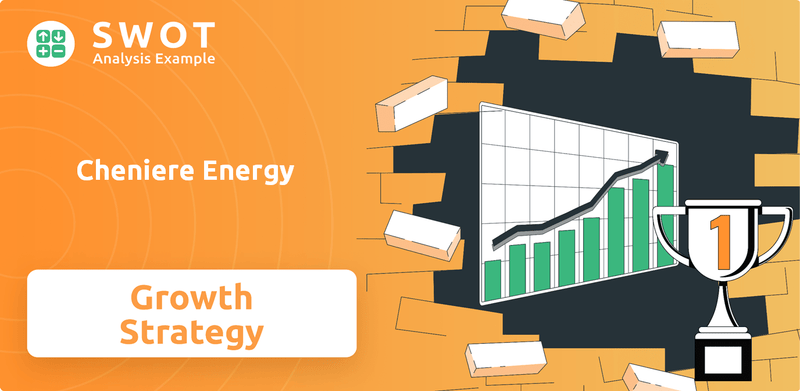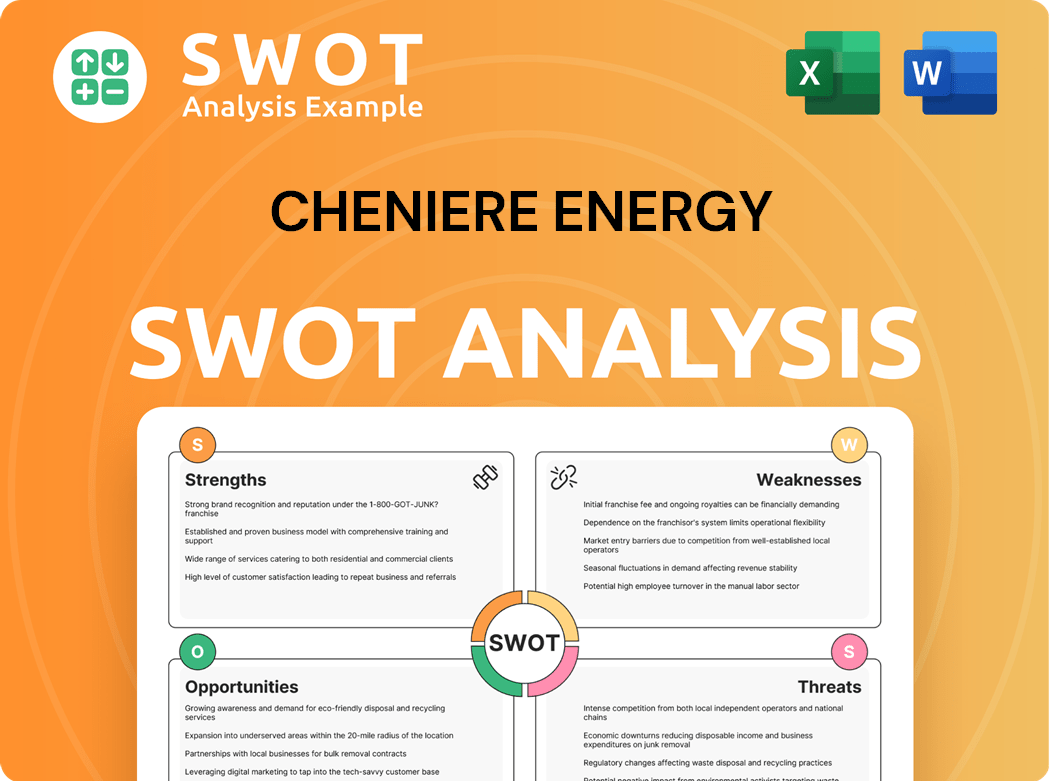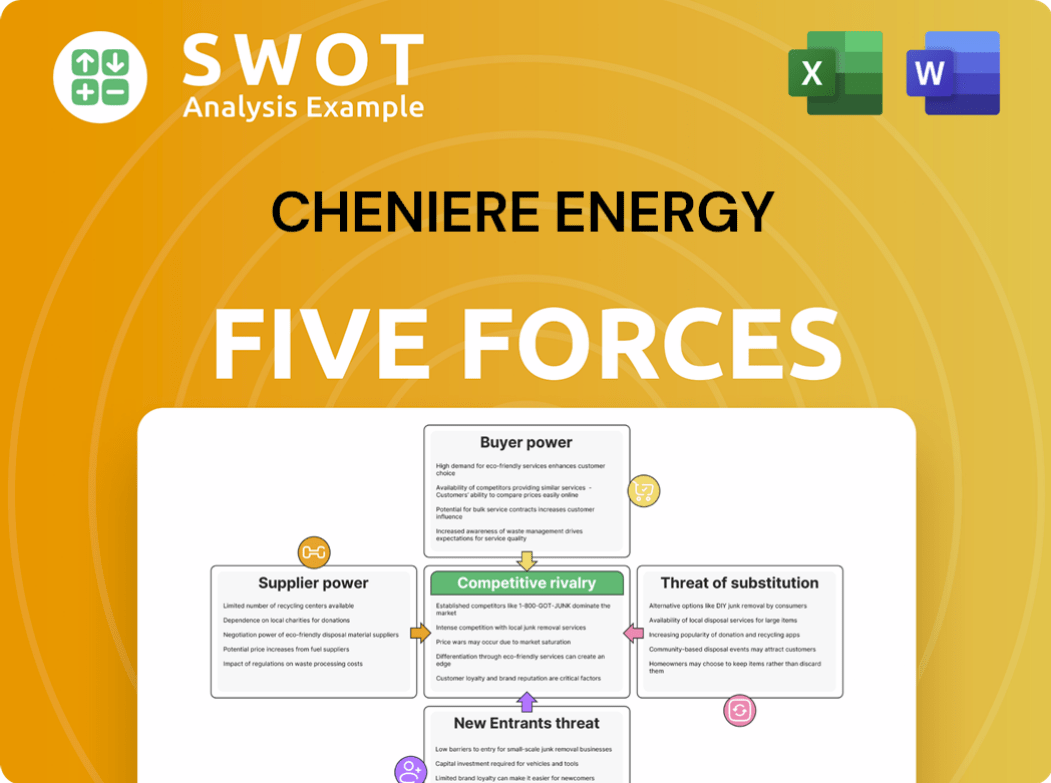Cheniere Energy Bundle
Can Cheniere Energy Continue to Dominate the LNG Market?
Cheniere Energy, a pioneer in the Liquefied Natural Gas (LNG) sector, has reshaped the global energy landscape. From its early days as an oil-and-gas explorer to its current status as a leading LNG exporter, Cheniere's strategic pivots have been nothing short of remarkable. This analysis delves into the core of Cheniere Energy's Cheniere Energy SWOT Analysis, exploring its growth strategy and future prospects in a dynamic market.

With a record-breaking 646 cargoes exported in 2024, generating approximately $15.7 billion in revenues, Cheniere Energy's success is undeniable. The company's future is intrinsically linked to its ability to navigate the evolving LNG market, capitalize on expansion opportunities, and maintain its competitive advantage. Understanding Cheniere Energy's growth strategy is essential for investors and industry professionals alike, especially given the increasing global demand for cleaner energy sources and the company's ambitious expansion plans.
How Is Cheniere Energy Expanding Its Reach?
Cheniere Energy is aggressively expanding its operations to capitalize on the growing global demand for Liquefied Natural Gas (LNG). The company's growth strategy focuses on increasing its production capacity and broadening its market reach. This involves significant investments in new facilities and strategic partnerships to secure long-term contracts.
The expansion initiatives are designed to meet the rising demand for LNG, particularly from Europe and Asia. These projects are expected to diversify revenue streams and provide stable cash flows through long-term contracts. The company's ability to execute these projects on time and within budget is crucial for its future success.
The company's commitment to these projects demonstrates its confidence in the long-term viability of the LNG market and its ability to maintain a competitive edge. For more background, you can read a Brief History of Cheniere Energy.
The CCL Stage 3 project in South Texas is a major expansion initiative. It is progressing ahead of schedule and on budget. This project will add over 10 million tonnes per annum (mtpa) of LNG production capacity.
Cheniere is also developing the SPL Expansion Project. This project aims to add up to approximately 20 mtpa of LNG production capacity. This expansion is crucial for meeting the growing global demand.
The CCL Stage 3 project includes seven midscale trains, increasing the total capacity of the Corpus Christi facility to over 25 mtpa. First LNG production from Train 1 of CCL Stage 3 was achieved in December 2024, with the first cargo loaded in February 2025. Substantial completion for Train 1 is anticipated by the end of the first quarter of 2025.
- Production ramp-up for Trains 1-3 is expected throughout 2025.
- The entire CCL Stage 3 project is projected to be finished by the second half of 2026.
- Cheniere Marketing entered a long-term Sale and Purchase Agreement (SPA) with Galp Trading S.A. to supply LNG starting in the early 2030s.
- The company's long-term contracts already cover approximately 95% of its total anticipated production through the mid-2030s.
Cheniere Energy SWOT Analysis
- Complete SWOT Breakdown
- Fully Customizable
- Editable in Excel & Word
- Professional Formatting
- Investor-Ready Format

How Does Cheniere Energy Invest in Innovation?
Innovation and technology are central to the growth strategy of the energy company, driving operational efficiency and sustainability within its Liquefied Natural Gas (LNG) production. The company focuses on continuous process optimization through the adoption of new technologies and data analytics, ensuring it remains competitive in the dynamic energy market.
A key element of this strategy is environmental stewardship, particularly in reducing greenhouse gas emissions. The company has established ambitious targets to minimize its environmental footprint, aligning with global efforts to combat climate change. This commitment enhances its reputation for operational transparency and reliability.
The company is dedicated to leveraging technology to enhance its operational capabilities. This includes digital transformation initiatives aimed at improving decision-making and optimizing supply chain management. The company's commitment to innovation is evident in its adoption of advanced technologies.
The company has set a methane emissions target of 0.03% per ton of LNG produced by 2027 across its export terminals. This goal underscores its commitment to environmental responsibility and sustainability within the LNG industry.
The LNG industry, including the company, is increasingly deploying advanced monitoring systems, such as drones and automated sensors. These technologies are used to detect and mitigate methane leaks in pipelines and storage facilities, which is crucial for meeting environmental targets.
Innovation in LNG production involves the use of advanced technologies such as digital twins, artificial intelligence (AI), and robotics. Digital twins create virtual models of physical LNG plants, enabling simulations, performance analysis, and predictive maintenance without disrupting actual operations.
The company's continuous efforts to improve efficiency and reliability through new technologies contribute directly to its growth objectives. This includes minimizing thermal losses and reducing overall energy consumption across its operations.
Digital transformation efforts focus on optimizing supply chain management, enhancing decision-making processes, and improving overall operational effectiveness. This strategic approach supports the company's ability to meet the growing global demand for LNG.
While specific details of R&D investments and key patents in 2024-2025 are not explicitly provided, the company's strategic focus on reducing emissions and optimizing operations through advanced technologies demonstrates its commitment to innovation and maintaining a competitive edge. This commitment is crucial for long-term success.
The company's commitment to innovation and technology, alongside its environmental goals, positions it well for future growth. For further insights into the company's ownership structure and financial performance, you might find the information in this article about Owners & Shareholders of Cheniere Energy helpful.
The company's technology strategy includes several key initiatives designed to enhance operational efficiency, reduce environmental impact, and improve overall performance. These initiatives are critical for maintaining a competitive advantage in the LNG market.
- Deployment of advanced monitoring systems to detect and mitigate methane leaks.
- Implementation of digital twins for virtual modeling and performance analysis of LNG plants.
- Use of artificial intelligence (AI) and robotics to optimize operations and maintenance.
- Focus on supply chain optimization through digital transformation.
Cheniere Energy PESTLE Analysis
- Covers All 6 PESTLE Categories
- No Research Needed – Save Hours of Work
- Built by Experts, Trusted by Consultants
- Instant Download, Ready to Use
- 100% Editable, Fully Customizable

What Is Cheniere Energy’s Growth Forecast?
The financial outlook for Cheniere Energy in 2025 appears robust, fueled by the anticipated increase in LNG production. The company's strategic focus on expanding its LNG production capacity, particularly through projects like Corpus Christi Stage 3, is expected to significantly contribute to its financial growth. This expansion is a key element of Cheniere Energy's growth strategy.
Cheniere Energy's financial performance in 2024 and early 2025 underscores its strong position in the Liquefied Natural Gas (LNG) market. The company's ability to secure long-term contracts for a significant portion of its production volume provides a stable revenue stream, which is a critical factor in its financial stability and future prospects. This stability is crucial in the dynamic energy market.
In the first quarter of 2025, Cheniere reported revenues of $5.4 billion, marking a 28% increase compared to the $4.3 billion in the same period of 2024. Consolidated Adjusted EBITDA for Q1 2025 reached $1.9 billion, a 6% increase from $1.8 billion in Q1 2024, and Distributable Cash Flow was $1.3 billion. For the full year 2024, Cheniere reported revenues of $15.7 billion, net income of $3.3 billion, Consolidated Adjusted EBITDA of $6.2 billion, and Distributable Cash Flow of $3.7 billion. The company's strategic capital allocation in 2024 included deploying approximately $5.4 billion towards accretive growth, balance sheet management, and shareholder returns.
For the full year 2025, Cheniere anticipates Consolidated Adjusted EBITDA to be between $6.5 billion and $7.0 billion. Distributable Cash Flow (DCF) is projected to range from $4.1 billion to $4.6 billion, reflecting the company's confidence in its expansion plans.
Over 90% of the forecasted operational volumes for 2025 are expected to be sold under long-term contracts. This provides a significant degree of revenue predictability, which is a key factor in the company's financial stability and investor confidence.
Cheniere maintains a robust liquidity position, with $10.553 billion in available liquidity as of March 31, 2025, including cash, restricted cash, and credit facilities. This financial flexibility supports its growth initiatives and operational needs.
Long-term debt decreased to $23 billion in 2024 from a peak of $31 billion in 2020. The company repurchased approximately 13.8 million shares of common stock for $2.3 billion in 2024 and plans to sustain 10% annual dividend growth.
Analysts have shown confidence in Cheniere Energy's future, with the 2025 Zacks Consensus Estimate for earnings rising to $12.02 per share. The company's strategic focus, strong financial position, and positive market trends position it well for continued growth. For more insights into the competitive landscape, consider exploring the Competitors Landscape of Cheniere Energy.
- The completion and ramp-up of the Corpus Christi Stage 3 project in 2025 are crucial for achieving projected financial results.
- Long-term contracts provide stability, but market fluctuations and geopolitical events could impact financial performance.
- The company's ability to manage debt and allocate capital effectively will be key to sustaining growth and shareholder value.
- Continued demand for LNG in international markets is essential for Cheniere Energy's long-term success.
Cheniere Energy Business Model Canvas
- Complete 9-Block Business Model Canvas
- Effortlessly Communicate Your Business Strategy
- Investor-Ready BMC Format
- 100% Editable and Customizable
- Clear and Structured Layout

What Risks Could Slow Cheniere Energy’s Growth?
Despite its promising growth strategy, Cheniere Energy, an energy company, faces several potential risks and obstacles that could impact its future prospects. These challenges span market dynamics, geopolitical factors, financial constraints, and operational hurdles. Understanding these risks is crucial for investors and stakeholders evaluating the company's long-term viability within the LNG market.
Market volatility and geopolitical instability are significant factors that could affect Cheniere Energy's performance. The company's long-term success is also subject to financial risks, including substantial debt and the potential for rising construction and operational costs. Addressing these challenges proactively will be essential for Cheniere Energy to maintain its competitive advantage and achieve its expansion plans.
Cheniere Energy's operations are exposed to market volatility, with LNG prices fluctuating based on supply and demand dynamics. The increasing number of new LNG facilities globally could potentially weaken spot prices and affect contract renewals. While long-term agreements offer some stability, the expanding capacity in the LNG market may dilute Cheniere's pricing power, which could impact profitability.
Geopolitical and regulatory risks pose a significant concern for Cheniere Energy. The company operates within the global LNG market, making it susceptible to trade tensions, energy policy shifts, and geopolitical events, such as the ongoing conflict in Ukraine.
Financially, Cheniere Energy faces substantial long-term debt, which stood at approximately $22.6 billion as of December 2024, with cash reserves of $3.1 billion. The debt-to-capitalization ratio of 71.3% indicates limited financial flexibility.
Supply chain vulnerabilities and internal resource constraints may also present obstacles. Depleting gas resources in traditional supply regions could affect supply stability, requiring Cheniere to monitor these developments to mitigate potential impacts.
The LNG market is subject to price fluctuations, and the addition of new facilities worldwide may weaken spot prices. Cheniere's long-term agreements provide stability, but the increasing market capacity could dilute its pricing power. This situation could affect the company's profitability.
Cheniere is exposed to geopolitical and regulatory risks, including trade tensions and energy policy shifts. Regulatory delays, especially for new projects like the CCL Midscale Trains 8 & 9, could impact project timelines. These factors introduce uncertainty into the LNG demand dynamics.
Cheniere's capital-intensive operations have resulted in substantial long-term debt, which was $22.6 billion as of December 2024, with cash reserves of $3.1 billion. The debt-to-capitalization ratio of 71.3% highlights limited financial flexibility.
Rising construction and operational costs could impact long-term profitability and lead to renegotiated contracts. Supply chain vulnerabilities and internal resource constraints could also present obstacles. The company mitigates some of these risks through its contracted cash flows.
Cheniere Energy Porter's Five Forces Analysis
- Covers All 5 Competitive Forces in Detail
- Structured for Consultants, Students, and Founders
- 100% Editable in Microsoft Word & Excel
- Instant Digital Download – Use Immediately
- Compatible with Mac & PC – Fully Unlocked

Related Blogs
- What are Mission Vision & Core Values of Cheniere Energy Company?
- What is Competitive Landscape of Cheniere Energy Company?
- How Does Cheniere Energy Company Work?
- What is Sales and Marketing Strategy of Cheniere Energy Company?
- What is Brief History of Cheniere Energy Company?
- Who Owns Cheniere Energy Company?
- What is Customer Demographics and Target Market of Cheniere Energy Company?
Disclaimer
All information, articles, and product details provided on this website are for general informational and educational purposes only. We do not claim any ownership over, nor do we intend to infringe upon, any trademarks, copyrights, logos, brand names, or other intellectual property mentioned or depicted on this site. Such intellectual property remains the property of its respective owners, and any references here are made solely for identification or informational purposes, without implying any affiliation, endorsement, or partnership.
We make no representations or warranties, express or implied, regarding the accuracy, completeness, or suitability of any content or products presented. Nothing on this website should be construed as legal, tax, investment, financial, medical, or other professional advice. In addition, no part of this site—including articles or product references—constitutes a solicitation, recommendation, endorsement, advertisement, or offer to buy or sell any securities, franchises, or other financial instruments, particularly in jurisdictions where such activity would be unlawful.
All content is of a general nature and may not address the specific circumstances of any individual or entity. It is not a substitute for professional advice or services. Any actions you take based on the information provided here are strictly at your own risk. You accept full responsibility for any decisions or outcomes arising from your use of this website and agree to release us from any liability in connection with your use of, or reliance upon, the content or products found herein.